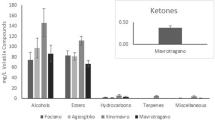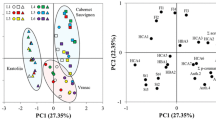Abstract
Wine comprises a beloved food and human companion since the early times of humans on earth. In this study, wine samples of different type (red, white, and rosé) and variety (Agiorgitiko, Augoustiatis, Cabernet Sauvignon, Syrah, Vlahiko, Assyrtiko, Chardonnay, Debina, Moschofilero, Vidiano, Syrah plus Mandilari, and Xinomavro) were subjected to physico-chemical and aroma compounds analyses, in an effort to characterize their identity and discriminate these samples according to variety using statistics. Results showed significant differences (p < 0.05) for wine samples of different variety in regard to the measured physico-chemical parameters (pH, electrical conductivity, total dissolved solids, salinity, L*, a*, b*, and Chroma*) and aroma compounds (alcohols, esters, phenolic compounds, pyran compounds, and terpenoids/norisoprenoids). Application of multivariate analysis of variance, linear discriminant analysis, and weighted least-squares regression analysis fired up the perfect varietal discrimination (~ 100%) of wine samples and modeling of results, contributing to new information in the literature about the identity of these wine varieties.



Similar content being viewed by others
References
Berger RF (2007) Flavours and fragrances, chemistry, bioprocessing and sustainability. Springer, Berlin, pp 1–649
Fraga H, Malheiro AC, Moutinho-Pereira J, Cardoso RM, Soares PMM, Cancela JJ, Pinto JG, Santos JA et al (2014) Integrated analysis of climate, soil, topography and vegetative growth in Iberian viticultural regions. PLoS ONE 9(9):e108078. https://doi.org/10.1371/journal.pone.0108078
King ES, Kievit RL, Curtin C, Swiegers JH, Pretorius IS et al (2010) The effect of multiple yeasts co-inoculations on Sauvignon Blanc wine aroma composition, sensory properties and consumer preference. Food Chem 122:618–626. https://doi.org/10.1016/j.foodchem.2010.03.021
Darias-Martín J, Socas-Hernández A, Díaz-Romero C, Díaz-Díaz E (2003) Comparative study of methods for determination of titrable acidity in wine. J Food Comp Anal 16:555–562. https://doi.org/10.1016/S0889-1575(03)00032-2
Zhu L, Wang L, Yang W, Guo D (2016) Physicochemical data mining of Msalais, a traditional local wine in Southern Xinjiang of China. Int J Food Prop 19(11):2385–2395. https://doi.org/10.1080/10942912.2015.1033549
Karimali D, Kosma I, Badeka A (2020) Varietal classification of red wine samples from four native Greek grape varieties based on volatile compound analysis, color parameters and phenolic composition. Eur Food Res Technol 246:41–53. https://doi.org/10.1007/s00217-019-03398-7
Lopez R, Aznar M, Cacho JF, Ferreira V (2002) Quantitative determination of minor and trace volatile compounds in wine by solid-phase extraction and gas chromatography with mass spectrometric detection. J Chromatogr A 966:167–177. https://doi.org/10.1016/s0021-9673(02)00696-9
Escudero A, Campo E, Farina L, Cacho J, Ferreira V (2007) Analytical characterization of the aroma of five premium red wines. Insights into the role of odor families and the concept of fruitiness of wines. J Agric Food Chem 55:4501–4510. https://doi.org/10.1021/jf0636418
Li H, Tao YS, Wang H (2008) Impact odorants of Chardonnay dry white wine. Eur Food Res Technol 227:287–292. https://doi.org/10.1007/s00217-007-0722-9
Tao Y, Li H, Wang H, Zhang L (2008) Volatile compounds of young Cabernet Sauvignon red wine from County (China). J Food Comp Anal 21:689–694. https://doi.org/10.1016/j.jfca.2008.05.007
Munoz-Gonzalez C, Rodriguez-Bencomo JJ, Moreno-Arribas MV, Pozo-Bayon MA (2011) Beyond the characterization of wine aroma compounds: looking for analytical approaches in trying to understand aroma perception during wine consumption. Anal Bioanal Che 401:1497–1512. https://doi.org/10.1007/s00216-011-5078-0
Rapp A, Mandery H (1986) Wine aroma. Experientia 42:873–884. https://doi.org/10.1007/BF01941764
Villamor RR, Ross CF (2013) Wine matrix compounds affect perception of wine aromas. Annu Rev Food Sci Technol 4:1–20. https://doi.org/10.1146/annurev-food-030212-182707
Schüttler A, Friedel M, Jung R, Rauhut D, Darriet P (2015) Characterizing aromatic typicality of Riesling wines: merging volatile compositional and sensory aspects. Food Res Int 69:26–37. https://doi.org/10.1016/j.foodres.2014.12.010
Ruiz J, Kiene F, Belda I, Fracassetti D, Marquina D, Navascués E, Calderón F, Benito A, Rauhut D, Santos A, Benito S (2019) Effects on varietal aromas during wine making: a review of the impact of varietal aromas on the flavor of wine. Appl Microbiol Biotechnol 103(18):7425–7450. https://doi.org/10.1007/s00253-019-10008-9
Chen L, Capone DL, Nicholson EL, Jeffery DW (2019) Investigation of intraregional variation, grape amino acids, and pre-fermentation freezing on varietal thiols and their precursors for Vitis vinifera Sauvignon blanc. Food Chem 295:637–645. https://doi.org/10.1016/j.foodchem.2019.05.126
Granato D, Putnik P, Bursać Kovačević D et al (2018) Trends in chemometrics: food authentication, microbiology, and effects of processing. Compr Rev Food Sci Food Saf 17(3):663–677. https://doi.org/10.1111/1541-4337.12341
Mclellan MR, Lind LR, Kime RW (1995) Hue angle determinations and statistical analysis for multi quadrant HUNTER L, a, b data. J Food Qual 18:235–240. https://doi.org/10.1111/j.1745-4557.1995.tb00377.x
Karabagias VK, Karabagias IK, Louppis BA, Kontominas MG, Papastephanou C (2019) Valorization of prickly pear juice geographical origin based on mineral and volatile compound contents using LDA. Foods 8:123. https://doi.org/10.3390/foods8040123
Montgomery DC, Peck EA, Vining GG (2012) Introduction to linear regression analysis, 5th edn. Wiley, New York, pp 188–193
Fleet GH (1990) Growth of yeasts during wine fermentations. J Wine Res 1(3):211–223. https://doi.org/10.1080/09571269008717877
Lingappa BT, Prasad M, Lingappa Y, Hunt DF, Biemann K (1969) Phenethyl alcohol and tryptophol: Autoantibiotics produced by the fungus Candida albicans. Sci 163(3863):192–194. https://doi.org/10.1126/science.163.3863.192
Eshkol N, Sendovski M, Bahalul M, Katz-Ezov T, Kashi Y, Fishman A (2009) Production of 2-phenylethanol from L-phenylalanine by a stress tolerant Saccharomyces cerevisiae strain. J Appl Microbiol 106(2):534–542. https://doi.org/10.1111/j.1365-2672.2008.04023.x
Mendes-Pinto MM (2009) Carotenoid breakdown products the—norisoprenoids—in wine aroma. Arch Biochem Biophys 483:236–245. https://doi.org/10.1016/j.abb.2009.01.008
Song J, Smart RE, Damberg RG, Sparrow AM, Wells RB, Wang H, Qian MC (2014) Pinot Noir wine composition from different vine vigour zones classified by remote imaging technology. Food Chem 153:52–59. https://doi.org/10.1016/j.foodchem.2013.12.037
Eggers NJ, Bohna K, Dooley B (2006) Determination of vitispirane in wines by stable isotope dilution assay. Am J Enol Vitic 57(2):226–232
Acknowledgements
The authors are grateful to the following wineries/estates/domaine: Zoinos Winery, Zitsa, Ioannina, Epirus; Ktima Gerovassiliou, Epanomi, Macedonia; Merkouri Estate, Korakochori, Ilia, Peloponnese; Diamantakis Winery, Heraklion, Crete; Skouras Domaine, Arcadia, Peloponnese; Hatzimichalis Domaine, Atalanti Valley, Fthiotida, Central Greece, for the donation of wine samples.
Author information
Authors and Affiliations
Contributions
Conceptualization, IKK and DS; methodology, IKK; software, AVB; validation, IKK, and AVB; formal analysis, IKK, DS, and AM; investigation, IKK, DS, AM; resources, AVB; data curation, IKK, and DS; writing—original draft preparation, IKK; writing—review and editing, IKK; visualization, IKK, and DS; supervision, IKK; project administration, IKK; funding acquisition, AVB. All authors have read and agreed to the published version of the manuscript.
Corresponding author
Ethics declarations
Conflict of interest
The authors declare that they have no conflict of interest.
Compliance with ethics requirements
This article does not contain any studies with human or animal subjects.
Informed consent
Not applicable.
Additional information
Publisher's Note
Springer Nature remains neutral with regard to jurisdictional claims in published maps and institutional affiliations.
Electronic supplementary material
Below is the link to the electronic supplementary material.
Rights and permissions
About this article
Cite this article
Karabagias, I.K., Sykalia, D., Mannu, A. et al. Physico-chemical parameters complemented with aroma compounds fired up the varietal discrimination of wine using statistics. Eur Food Res Technol 246, 2233–2248 (2020). https://doi.org/10.1007/s00217-020-03568-y
Received:
Revised:
Accepted:
Published:
Issue Date:
DOI: https://doi.org/10.1007/s00217-020-03568-y




